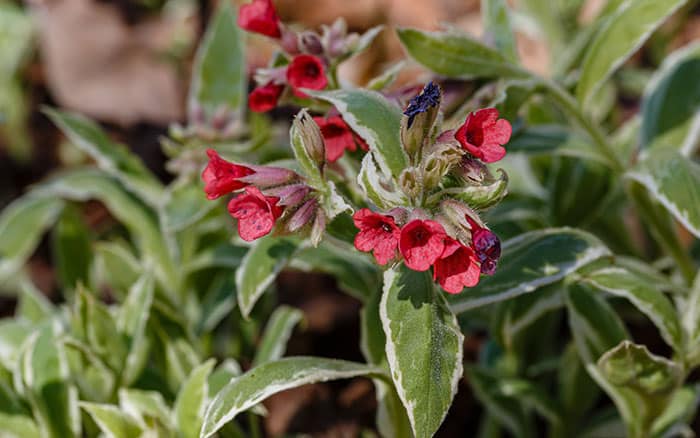March is the start of the busy season in the gardening calendar and is also the month that brings with it the official first day of spring. The clocks go forward too, and as the hours of daylight start to increase, so do the number of flowers appearing in the garden. Here are ten plants for March that are sure to ‘wow’ you with their petal power.
1. Pulmonaria rubra (red lungwort)
This very pretty, dainty flowered perennial gets its common name from the fact that its mottled leaves were once thought to resemble lungs. It’s one of the first of its type to flower, making it a valuable plant for pollinating insects, particularly bees. It provides great ground cover for shady areas. Apart from tidying up the old leaves after flowering, is a very undemanding plant requiring very little maintenance.
- Flowers in spring
- Fully hardy
- Grows to 40cm tall
- Moist but well-drained soil
- Full shade or partial shade
- Sheltered

2. Chaenomeles speciosa (flowering quince)
This underrated, easy to grow shrub is covered in delightfully cheerful orange-flame flowers on bare stems for weeks on end at this time of the year. They often produce green or yellow fruit at the end of the summer, which can be turned into a deliciously flavoured jelly. If left unpruned it makes a wonderful light and airy large shrub. Alternatively, it can be pruned and trained against a wall, even a shady one.
- Flowers in spring
- Fully hardy
- Grows up to 2.5m tall
- Moist but well-drained or well-drained soil
- Full sun or partial shade
- Exposed or sheltered

3. Pulsatilla vulgaris (pasqueflower)
Another beautiful, early spring flowering perennial that produces the most delicate looking silky flower buds that open to reveal purple flowers. As the flowers start to age, they develop striking seed heads as well as extremely attractive silvery fern like leaves. The foliage extends the period of interest well beyond its flowering time.
- Flowers in spring
- Hardy
- Grows to 50cm tall
- Well-drained soil
- Full sun
- Exposed or sheltered

4. Ribes odoratum (buffalo currant)
During March, this plant starts to produce pretty, small lemon-coloured flowers that give off a delightful spicy scent. It looks wonderful with deep purple crocus growing at the base and during autumn months the leaves turn handsome shades of deep red-purple.
- Flowers in spring
- Hardy
- Grows to 2m tall
- Moist but well-drained or well-drained soil
- Full sun
- Sheltered

5. Lathyrus vernus (spring pea)
This is one of the very earliest perennials to flower producing numerous thin stems which, as they unfurl, reveal masses of small purple flowers. The foliage is dark green, joined by red-purple flowers. They’re a great addition to rock gardens.
- Flowers in spring
- Fully hardy
- Grows to 30cm tall
- Moist but well-drained soil or well-drained soil
- Full sun or partial shade
- Exposed or sheltered

6. Bergenia (elephant’s ears) ‘Claire Maxine’
This group of tough evergreen perennials have wide, leathery leaves which become great weed suppressants as they develop into thick clumps. This variety has an amazingly long period of flowering. Magenta pink flowers bloom above shiny, round leaves on and off from now all the way to October.
- Flowers in spring and summer
- Fully hardy
- Grows to 50cm tall
- Moist but well-drained soil
- Full sun or partial shade
- Exposed or sheltered

7. Viburnum tinus (laurustinus)
A reliably hardy evergreen shrub that can be used in a variety of ways; as hedging, grown as a free-standing shrub or for privacy screening. It has dense, dark, shiny oval leaves which make a great backdrop for the flowers which start off with a pinkish hue developing into a strong white as the flowers fully open.
- Flowers in spring
- Hardy through most of the UK
- Grows to 3m tall
- Moist but well-drained or well-drained soil
- Full sun, partial shade or full shade
- Sheltered

8. Prunus (ornamental cherry) ‘Spire’
If you have space for this large, conical shape upright cherry, it will reward you with some of the earliest blossom of the various ornamental cherries. Often seen in parks and lining pavements, the pretty pink flowers can appear as early as late March. The blooms are set off beautifully by the richly coloured, reddish-purple leaves which change colour over the season. They turn yellow, then a deep green, before finally developing rich red tints during the autumn months.
- Flowers in spring
- Fully hardy
- Grows up to 8m tall
- Moist but well-drained or well-drained soil
- Full sun
- Exposed or sheltered

9. Helleborus x sahinii (hellebore)
This group of perennial plants are brilliant at providing colour for weeks on end during the winter and early spring months. They produce elegantly shaped flowers above clumps of large, dark green leaves. They are excellent for growing in shadier parts of the garden. This variety is renowned for producing its pink flushed green flowers for an incredibly long period of time and looks great in a woodland setting.
- Flowers in winter
- Hardy through most of the UK
- Grows to 50cm tall
- Moist but well-drained soil
- Full sun or partial shade
- Sheltered

10. Scilla siberica (Siberian squill)
If you’re looking for pretty, blue flowering bulbs to plant en masse below trees and shrubs, then these are the perfect choice. They produce a sea of nodding, dainty looking blue flowers. Originating from Russia they are surprisingly hardy and, given the right conditions, should quickly establish and naturalise in both lawns as well as semi-shaded parts of the garden.
- Flowers in spring
- Fully hardy
- Grows to 20cm tall
- Well-drained soil
- Full sun or partial shade
- Exposed or sheltered


Leave A Comment